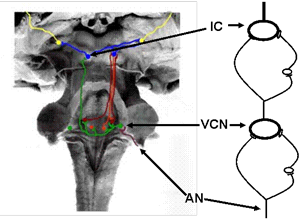Auditory Processing of Complex Sounds
We are currently studying two specific problems: detection of acoustic signals in background noise, and detection of fluctuations in the amplitude of sounds. These problems are of interest because they are tasks at which the healthy auditory system excels, but they are situations that can present great difficulty for listeners with hearing loss. We study the psychophysical limits of ability in these tasks, and we also study the neural coding and processing of these sounds using stimuli matched to those of our behavioral studies. Computational modeling helps bridge the gap between our behavioral and physiological studies. For example, using computational models derived from neural population recordings, we make predictions of behavioral abilities that can be directly compared to actual behavioral results. The cues and mechanisms used by our computational models can be manipulated to test different hypotheses for neural coding and processing.

Schematic drawing of a model for amplitude modulation processing along the ascending auditory pathway (right) next to a ventral view of the brainstem (left), with relevant anatomical regions indicated.
Researcher: Laurel H. Carney, Ph.D.
Auditory Neuroscience; neurophysiological, behavioral, and computational studies of hearing; signal processing for hearing aids.
